Our dogs are cherished members of our households, providing us with companionship, loyalty, and endless joy. As responsible pet owners, it’s our duty to create a safe and secure environment for our four-legged friends. Part of ensuring their well-being involves being aware of potential hazards, especially those that may be found in our gardens. In this article, we embark on a journey to explore the safety of Celosia, those striking and vibrant garden flowers, and whether they pose any risks to our canine companions. Understanding the nature of these unique blooms is vital for responsible gardening and safeguarding our beloved dogs from potential dangers in our outdoor spaces.
What Is Celosia?
Celosia, scientifically known as Celosia argentea, is a captivating flowering plant that belongs to the amaranth family, Amaranthaceae. These distinctive garden flowers are celebrated for their unusual and eye-catching appearance. Celosia plants are characterized by their striking, flame-like flower heads that come in various vibrant colors, including brilliant reds, fiery oranges, and rich purples. These eye-catching blossoms have earned them the common names “Cockscomb” and “Woolflowers” due to their intriguing, textured flower heads that resemble a rooster’s comb or a woolly appearance.
Celosia plants can be grown as annuals or perennials, depending on the climate and local growing conditions. Their unique appearance and vibrant hues make them a popular choice among gardeners looking to add a touch of drama and color to their outdoor landscapes. However, amidst their visual splendor, questions may arise regarding whether Celosia flowers harbor any hidden dangers for our canine companions. Let’s delve deeper into the world of Celosia to uncover the potential risks, if any, that these garden blooms may pose to dogs.
Potential Dangers of Celosia to Dogs
While Celosia plants are renowned for their striking and vibrant appearance, they are generally considered non-toxic to dogs when ingested in small quantities. However, there are certain aspects of Celosia that dog owners should be aware of to ensure the safety of their pets. One potential concern is that Celosia plants may have small, hard seeds that, if ingested by dogs in significant amounts, could pose a choking hazard or lead to gastrointestinal discomfort.
It’s important to note that Celosia plants are not considered highly toxic to dogs, and severe poisoning cases are rare. Nevertheless, responsible pet ownership entails being mindful of what your dog has access to in the garden and taking precautions to prevent any potential hazards.
Common Symptoms of Celosia Poisoning in Dogs
In the rare instances when dogs experience adverse reactions to Celosia plants, the symptoms are generally mild and may include:
- Gastrointestinal Upset: Ingesting a significant amount of Celosia seeds or plant material could lead to symptoms such as vomiting, diarrhea, or mild stomach discomfort.
- Choking Hazard: The hard seeds of Celosia plants may present a choking hazard, particularly for dogs that are prone to eating non-food items.
It’s important to emphasize that severe poisoning from Celosia plants is exceptionally uncommon in dogs. However, if you suspect that your dog has ingested a substantial quantity of Celosia or is displaying concerning symptoms, it’s advisable to seek veterinary attention promptly. Veterinary professionals can provide appropriate guidance and treatment to ensure your dog’s well-being.
Overall, Celosia plants are not a significant source of concern for dog owners, and the risks associated with these garden flowers are minimal. Responsible gardening practices and awareness of potential hazards are advisable to create a safe outdoor environment for both your canine companion and your beloved garden.
Preventing Celosia Poisoning
Preventing Celosia poisoning in dogs primarily involves responsible gardening practices and vigilance. Here are some practical steps for dog owners to minimize any potential risks:
- Supervision: When your dog is in the garden or outdoor spaces where Celosia plants are present, supervise their activities to prevent them from nibbling on or ingesting plant material.
- Training: If your dog has a tendency to explore plants, consider additional training to discourage this behavior.
- Garden Safety: Create designated areas for your dog to play and roam that are separate from your garden to minimize their access to plants.
- Plant Placement: When planting Celosia or any other potentially hazardous plants, ensure they are located in areas that are less accessible to your dog.
- Regular Inspection: Routinely inspect your garden for any plant parts, including seeds or flowers, that may have fallen onto the ground and remove them promptly.
By practicing these preventive measures, you can enjoy the vibrant beauty of Celosia plants in your garden while keeping your canine companion safe from potential hazards.
What to Do If Your Dog Is Exposed
If you suspect that your dog has ingested a significant quantity of Celosia seeds or plant material and is displaying concerning symptoms such as vomiting, diarrhea, or choking, take the following steps:
- Contact Your Veterinarian: Reach out to your veterinarian or an emergency pet clinic immediately for guidance and assistance.
- Provide Information: Be prepared to provide information about the quantity and type of Celosia ingested, as well as the onset and severity of symptoms.
- Follow Veterinary Advice: Follow the guidance and recommendations provided by your veterinarian for appropriate care and treatment.
Conclusion
Celosia, with its unique and vibrant appearance, is generally not a significant source of concern for dog owners. While there are potential hazards associated with Celosia seeds and plant material, cases of severe poisoning in dogs are rare. Responsible gardening practices, such as supervising your dog in the garden and preventing access to potentially harmful plants, can help ensure the safety of your canine companion.
Ultimately, Celosia can continue to adorn your garden with its captivating beauty, and with proper precautions, you can create a harmonious outdoor environment where your dog can safely explore and play. By striking a balance between your love for gardening and your commitment to pet safety, you can enjoy the best of both worlds.




